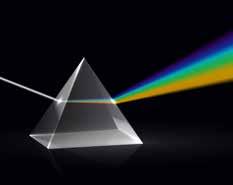LR&T essentials
January/February 2021
NEITHER MYTH NOR MAGIC Iain Carlile looks at three recently published Lighting Research and Technology papers exploring humancentric lighting, lighting control and light pollution ith regards to the terminology 'human-centric lighting' (HCL), Houser et al summarise the many known beneficial effects of lighting on humans, demonstrating that HCL has sound benefits, despite the term being tainted by some misleading marketing claims. The authors propose using the term 'integrative lighting' to avoid hype while encapsulating what lighting aspires to be, embodying concepts both old and some new. The old includes good design (and equipment), visibility, visual comfort and visual amenity. Complementing the old concepts is the newer awareness of how light and lighting influence non-visual responses in humans. From their study the authors make recommendations for future development including:
W
● Agreed method for quantifying potency of a light stimulus ● Logistic functions that relate the biological potency of a lighting stimulus to different responses ● Greater understanding of both short-term (minutes) and long-term (hours to days and longer) adaptation of light responses, to better design biologically effective lighting
● Lighting recommendations, metrics and design procedures that make it easy to ensure enough light is received at the eye for common directions of view, without visual discomfort In conclusion, the authors note that 'Human-centric lighting is neither a myth nor magic, but a metaphor for what good lighting has always done: support human outcomes.' Rondelez et al present a compact lighting system designed to allow the direction and divergence of a light beam to be varied electronically. The method employed to achieve this beam adjustment uses a focus tunable lens and rotatable mirror combined with two custom aplanatic lenses in front of a high-output LED light source. A prototype of the proposed system was tested under experimental conditions, and then this performance was compared with optical simulations using the Light Tools ray-tracing software.
Street Light Emissions (a)
(b)
(c)
(d)
DNB radiance
Patterns of light emission from Tucson, Arizona (CCM Kyba et al)
Iain Carlile, FSLL, is a past president of the SLL and a senior associate at dpa lighting consultants
Lighting Research and Technology: OnlineFirst In advance of being published in the print version of Lighting Research and Technology (LR&T), all papers accepted for publishing are available online. SLL members can gain access to these papers via the SLL website (www.sll.org.uk) Human-centric lighting: Myth, magic or metaphor? KW Houser, PR Boyce, JM Zeitzer and M Herf Compact illumination system with variable beam direction and beam divergence N Rondelez, WR Ryckaert and Y Meuret Direct measurement of the contribution of street lighting to satellite observations of night-time light emissions from urban areas CCM Kyba, A Ruby, HU Kuechly, B Kinzey, N Miller, J Sanders, J Barentine, R Kleinodt and B Espey
15
Twitter: @sll100 Fit slope (e)
17
While the adaptive functionality of the system was proved, large differences were identified in the simulations and measurements, with beam divergence being greater in the physical prototype. Colour and illuminance uniformity were also identified to be a problem in the physical prototype. Although these problems can be improved with a diffuser, this results in a decrease in system efficacy and an increase in the beam spread. Higher quality lenses are proposed to correct these issues, but the authors note a diffuser may still be required. Meanwhile Kyba et al have looked at light pollution, undertaking a study measuring light emissions from the city of Tucson, USA. The aim was to calculate the contribution to light pollution from the city’s street lighting. Tucson has a smart-city public street lighting system that allows the lighting output of the city’s system to be varied. By varying the output by a known amount over a period of 10 days it was possible to measure the contribution that street lighting made to light pollution. It was found that the actual value was 13 per cent of the total radiance recorded from Tucson from space after midnight. If Tucson did not use the smart-city system dimming capability, this value would raise to 18 per cent. Given these figures are a relatively small percentage of the overall emitted light from Tucson, it suggests that other lighting installations are contributing heavily to light pollution from the city and the need to consider other light sources in energy and light pollution management.
Fit fraction of streetlight (f)






